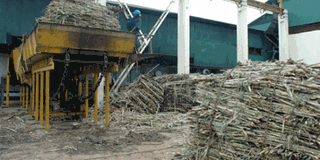Kakira Sugar Works plans to produce Ethanol fuel by 2016

Sugarcane is loaded for crushing at a factory. Kakira and other processors of the sweetener are lobbying government to pass policy before production starts. File photo
What you need to know:
The ethanol from the facility that will have capacity to produce 20 million litres annually will be distilled from 85,000 metric tonnes of molasses, the result of processing 2 million tonnes of cane.
Kakira Sugar Works Ltd., Uganda’s biggest processor of the sweetener, plans to build an ethanol plant by the end of 2016 after it spent $75 million (Shs197 billion) expanding cane-crushing and power operations over the past two years.
The ethanol from the facility that will have capacity to produce 20 million liters (5.3 million gallons) annually will be distilled from 85,000 metric tons of molasses, the result of processing 2 million tons of cane, Kenneth Musinga Barungi, an assistant to the company’s general manager, said by e-mail yesterday.
“Directors are discussing the design, possible equipment suppliers and costs, with plans for production to start by mid-December 2015,” he said. Officials visited India and China for advice on feasibility studies, Barungi said.
Kakira and other producers currently sell molasses cheaply to distillers of a local gin.
The landlocked nation may produce a surplus of sugar this year, with output rising 32 per cent to 442,550 tonnes from a year earlier, according to its manufacturers’ association. Domestic demand is about 320,000 tons annually.
Uganda consumed 17,000 barrels of petroleum products daily in 2012, according to the U.S. Energy Information Administration.
The ethanol will be blended with gasoline to cut fuel costs and the mixture will range from 8 per cent to 15 per cent, Barungi said. Kakira and other processors of the sweetener are lobbying the East African nation’s government to pass policy before production starts, he said.
Electricity investment
The company is owned by the Kakira-based Madhvani Group, one of the nation’s leading industrial groups, which is classified by Forbes magazine among the 10 biggest family companies in Africa.
The group invested $75 million (Shs197 billion) since 2012 in Kakira’s cane-crushing facilities and in generating electricity from bagasse, a cane fibre, Barungi said.
It uses 16 megawatts of its 50 megawatts of capacity, selling the remainder to the national grid, he said.
Power capacity
Uganda’s installed power capacity is 810 megawatts, according to the Electricity Regulatory Authority.
Eskom Holdings Ltd., the utility that generates about 95 percent of South Africa’s power, had installed capacity of 41,995 megawatts at the end of March, it said on July 11.
However, the country needs to find additional sources of power given that the demand for electricity is growing at an annual rate of between 10-12%.
As a result, the country is looking at alternative sources of energy. Last year, Electricity Regulatory Authority and the Ministry of Energy and Mineral Development issued several permits for different projects that will ease the increasing power demand in the country.




